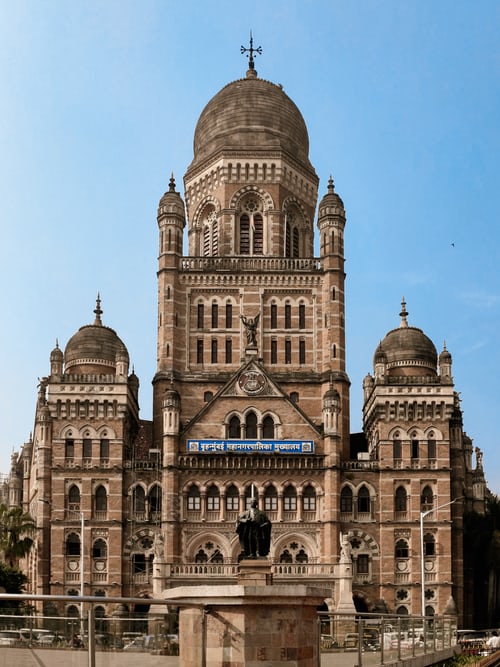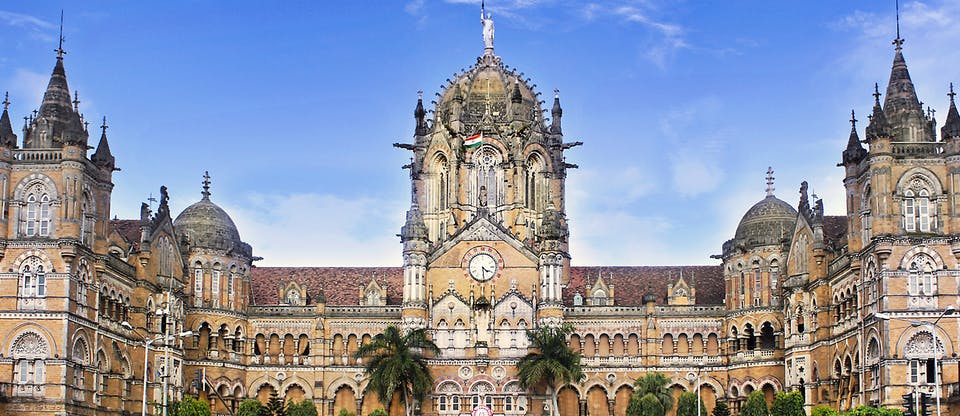Description
Chhatrapati Shivaji Maharaj Terminus is one of the UNESCO World Heritage site. It is a historicrailway station and headquarters to the Central Railways. Built in May 1888, the place is popular for its wonderful architecture. This Place is Mumbai's point of interest among youngster. The first railway line in India was inaugurated on 16th April, 1853 and ran the distance of 21 miles from Bori Bunder in Bombay to Thane. In May 1878, work on building a grand new terminus began under the architectural expertise of Mr. Frederick William Stevens, which took 10 years to complete.
The terminus was designed in a Gothic style, adapted to suit the Indian context. It displays exquisite ornamentation and embellishment on the front façade. The majestic dome is surmounted by a colossal figure representing ‘progress’, whereas each of the main gables carries a distinctive sculpture representing engineering, commerce and agriculture. The west front is approached by a grand gateway and sculptures of a lion and tiger couchant (representing England and India). The interior, consisting of a booking office, is created with Italian marbles, polished Indian blue stones and elaborate stone arches that are carved foliage and grotesques. Other features include a tessellated floor, dados of glazed tiles, stained glass windows and galleries of highly ornamented iron work executed by the students of J.J. School of Art.
After the remodelling of the terminus in 1929, the new buildings included refreshment rooms, dressing rooms and bathrooms. The former station, which adjoined it, was reserved for suburban traffic. The new wing had 13 platforms, the last five being exclusively used for trains running through various parts of India. Over the following decades, more additions were carried out to the original buildings.
Designed by architect Frederick William Stevens, Victoria Terminus represented the modernity of the British Empire and the railways’ engineering prowess. However, it was the result of a decade of work by the British and by Indians. In his Sahapedia interview, Mehrotra says that except for VT’s chief architect, Stevens, “everyone from the ‘mistry’ to ‘mukaddam’ to the chief craftsman was Indian”. Stevens designed the building and supervised the project but the groundwork was done by PWD’s assistant engineer Sitaram Khanderao Vaidya and PWD supervisor Mahderao Janardhan.
Among the top 10 railway stations in the world, the Chhatrapati Shivaji Maharaj Terminus (CSMT) has stood tall for 130 years and has become the symbol of Mumbai. Unless a major natural calamity strikes, it could stand for another 500 or 1,000 years.

More Details
On 1st January, 1882, the Bombay Passenger Station was opened for traffic. The
terminus was later re-named after the Queen Empress on Jubilee Day, in 1887.In time, Victoria
Terminus, now known as Chhatrapati
Shivaji Maharaj Terminus, came to be known as one of the finest railway stations ever created in the
world.
The interior of the building was conceived as a series of large rooms with high ceilings. It is a
utilitarian building and has had various changes required by the users, not always sympathetic. It
has a C-shaped plan which is symmetrical on an east–west axis. All the sides of the building are
given equal value in the design. It is crowned by a high central dome, which acts as the focal
point. The dome is an octagonal ribbed structure with a colossal female figure symbolizing Progress,
holding a torch pointing upwards in her right hand and a spoked wheel in her left hand. The side
wings enclose the courtyard, which opens on to the street. The wings are anchored by monumental
turrets at each of their four corners, which balance and frame the central dome. The façades present
the appearance of well-proportioned rows of windows and arches. The ornamentation in the form of
statuary, bas-reliefs, and friezes is exuberant yet well controlled.
Chhatrapati Shivaji Terminus (formerly Victoria Terminus) as the building most emblematic of Mumbai
because more than three million of the city’s residents rush through its portals every day. But this
late-19th-century railway terminus happens also to be one of the finest examples of colonial
architecture in the country, representing an east-meets-west style that developed here.
Highlights: The site is a fine illustration of Victorian Gothic Revival architecture in the country. It is operated by Central Railway Zone of India having 18 platforms in total. The main highlight of this station was the filming of the song ‘Jai Ho’ from the movie “Slumdog Millionaire” in 2015 and also in the movie “Ra-One”. It was also featured in, World’s Busiest Railway 2015.
Distance from Mumbai Airport: It is 25 km from Mumbai
Airport.
Entrance fee: The entry is free of cost.
Timing: Always Open.
Location: It is located at D.N Road, Mumbai.

